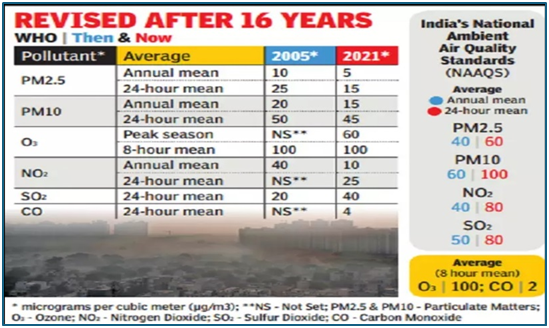Why in news?
A study published in The Lancet Planetary Health journal found that air pollution is a major health concern in India.
In 10 of the largest and most polluted cities, including Delhi, Bengaluru, and Mumbai, 7.2 percent of all daily deaths were linked to PM2.5 levels. These levels were higher than the safe exposure guidelines set by the World Health Organization (WHO).
What’s in today’s article?
- WHO’s revised air quality guidelines 2021
- Key highlights of the reports
- Steps taken to control air pollution
WHO’s revised air quality guidelines 2021

- About
- In September 2021, the World Health Organization (WHO) has strengthened its air quality guidelines.
- The revised norms recommend air quality levels for six pollutants:
- Ozone, nitrogen dioxide, sulphur dioxide and carbon monoxide.
- The other two are PM10 and PM2.5 -- particulate matter equal or smaller than 10 and 2.5 microns in diameter.
- The recommended levels for all the six pollutants have been revised downwards from the existing norms that have been in place since 2005.
- Non-binding in nature
- The WHO norms are not binding on any country.
- These are only recommended norms considered safe for human health, backed by scientific studies. However, air quality does affect the international image of a country.
Key highlights of the study conducted by The Lancet Planetary Health journal
- Observations made w.r.t. Delhi
- 11.5% of annual deaths (around 12,000) are due to air pollution.
- This is the highest percentage for any city in India.
- Situation across 10 Major Cities
- Ahmedabad, Bengaluru, Chennai, Delhi, Hyderabad, Kolkata, Mumbai, Pune, Shimla, and Varanasi were included in the study.
- More than 33,000 deaths annually are attributed to air pollution.
- Shimla has the lowest pollution-related mortality burden, with 59 deaths annually (3.7% of total deaths).
- On average, 7.2% of all deaths in these cities are caused by air pollution.
- PM2.5 Exposure
- PM2.5 levels in these cities exceed WHO's safe limit (15 micrograms per cubic metre) 99.8% of the days.
- Data collected from civil registries between 2008 and 2019 for daily deaths.
- Over 3.6 million deaths examined.
- Researchers used a machine-learning-based exposure model for detailed PM2.5 data.
- Mortality and Pollution Levels
- Mortality increases by 1.42% for every 10 micrograms per cubic metre rise in PM2.5 levels.
- Less polluted cities showed a higher risk of mortality due to pollution increase.
- A spike in air pollution in Indian cities that have clean air may raise death rates higher than in cities that have higher pollution loads.
- Thus, the same increase in air pollution in, say, Bengaluru, can raise death rates more than in Delhi, which has much higher background levels of air pollution.
- Research Insights
- Cities with lower pollution levels, like Bengaluru and Shimla, showed stronger effects due to sharp risk increases at lower exposure levels.
- The study is a pioneering effort in understanding the relationship between short-term air pollution exposure and mortality in India.
- It offers new insights into the health impacts of air pollution in various agro-climatological zones of India.
Steps Taken by the Indian Govt
- National Clean Air Programme (NCAP)
- NCAP was launched in January 2019 to improve air quality through a city-specific action plan.
- Under NCAP, India has a target to reduce 20-30% of PM2.5 and PM10 concentrations by 2024 from 2017 levels.
- PRANA Portal
- It was launched to monitor the implementation of NCAP
- National Air Quality Index (AQI) –
- It was launched in October 2014 to disseminate information on air quality in an easily understandable form for the general public.
- The measurement of air quality is based on eight pollutants, namely, PM10, PM2.5, NO2, SO2, CO, O3, NH3, and Pb
- Under the authority of the Air (Prevention and Control of Pollution) Act of 1981, India’s Central Pollution Control Board sets national ambient air quality standards.










